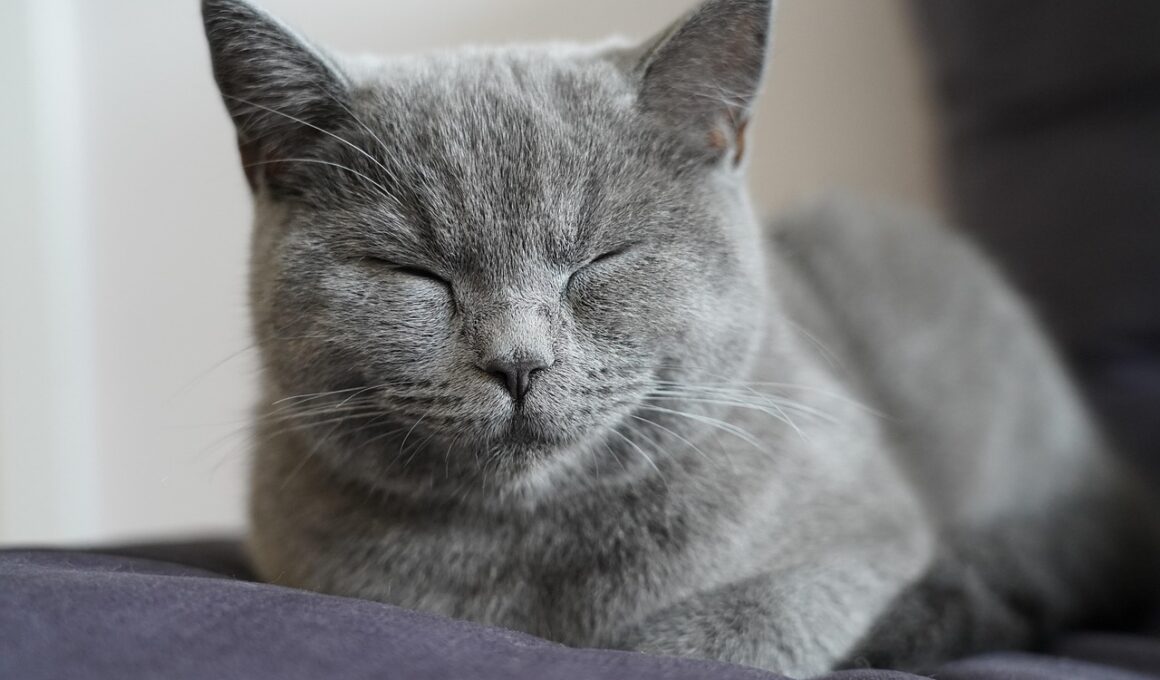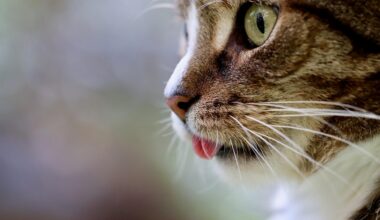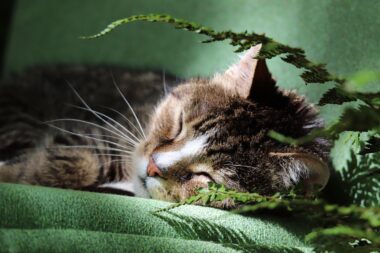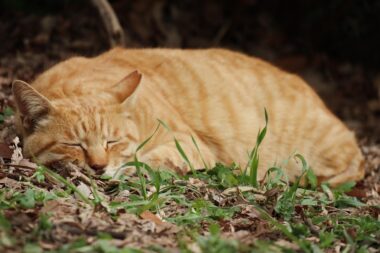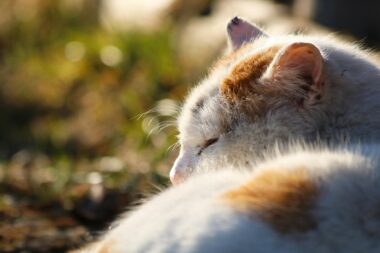Tips to Monitor and Improve Your Cat’s Sleep
Understanding your cat’s sleeping habits is crucial for their overall well-being. Cats typically sleep between 12 and 16 hours per day, often due to their natural instincts as predators. To effectively monitor your feline companion’s sleep patterns, start by observing their daily behavior. Note the duration and location of their naps, as well as any changes over time. Cats may change their sleeping spots, often favoring warm and soft areas. Therefore, providing them with comfy beds will encourage restful sleep. Check to see if stress or environmental factors might be disrupting their sleep, such as noise levels or the presence of other pets. Keep an eye on their activity levels throughout the day; increased playtime can help satisfy their need for exercise and encourage more extended periods of sleep. Furthermore, consider establishing a consistent routine, where feeding and playtime are scheduled. This can help regulate your cat’s natural rhythm, promoting better sleep quality. By being attentive to these factors, you can ensure your cat receives the restful sleep they need to thrive.
In addition to monitoring your cat’s sleep habits, creating a quiet environment can greatly benefit their sleep quality. Minimize distractions by reducing noise levels, closing curtains to block bright light, and providing secluded space for your cat to relax. A cozy, dark, and calm area will promote a feeling of safety and comfort, encouraging your pet to sleep more soundly. Incorporate soft bedding into their sleeping space to ensure comfort; cats enjoy materials that are warm and plush to snuggle into during their naps. Regularly cleaning their sleeping area helps eliminate allergens and irritants. You may also want to use pheromone diffusers, which can help reduce anxiety in cats. This, in turn, enhances sleep quality. If your feline suffers from medical issues, consult your veterinarian about tailored solutions to their unique sleeping problems. Sometimes, behavioral issues or health concerns, such as arthritis, may affect their ability to rest. Keep an open line of communication with a vet regarding changes in their sleeping patterns, as these could signal underlying health concerns that may require attention.
The Role of Play in a Cat’s Sleep
Engaging your cat in regular play sessions can significantly impact their sleep quality. Cats are natural hunters and love to chase after toys that mimic prey. Using feather wands, laser pointers, or interactive toys fosters physical activity and mental stimulation. Around 30 minutes of play each day can tire out your cat, promoting natural sleepiness when it’s time to rest. Consider rotating different toys to keep their interest piqued, preventing boredom and continually stimulating their hunting instincts. Just as important is understanding a cat’s predatory behavior; they rely on short bursts of energy followed by periods of rest. Scheduling playtime after meals can encourage your cat to settle and sleep afterward. Look for signs that your cat is engaging in play like pouncing, stalking, and batting at toys. Reinforcing play can also strengthen your bond with your pet. Over time, consistent play and awareness of their energy levels can ensure a balance between activity and rest. The importance of play should never be underestimated, as it contributes significantly to a cat’s overall health and sleep patterns.
Implementing a consistent sleep schedule is vital in helping your cat achieve a routine that prioritizes rest. Having a set feeding and playing schedule creates predictability that your feline friend will come to appreciate. Cats thrive on routine, and a consistent environment allows them to relax more easily. At night, use dim lighting, create a calm atmosphere, and limit stimulation to encourage sleep during appropriate hours. Monitor your cat’s behavior to identify when they seem most active and when they prefer to rest, catering to their natural instincts. If your cat is resistant to sleep or is behaving unusually at night, try to identify potential triggers. For example, could household traffic or family activities be distracting? Address any distractions during their bedtime, and consider how you might adjust your routine to accommodate their needs. In time, your cat will learn to trust that their environment is supportive of restful sleep. Establishing these habits can lead to improved long-term health and overall happiness for your feline family member.
Understanding Sleep Cycle Differences
Moreover, it is important to be aware of the sleep cycles of cats, which differ from humans. Cats enter into deeper sleep stages more quickly than humans do, experiencing both REM and non-REM sleep. REM sleep is quite critical as it is during this phase that dreaming occurs, a vital component for a cat’s mental well-being. Understanding these cycles enables cat owners to recognize the signs that their pet is getting sufficient rest. If you notice your cat frequently waking up and appearing unsettled, it may indicate an underlying issue disrupting their sleep. Watching their body language can be a powerful tool; curled-up positions tend to indicate comfort and safety, while abrupt awakenings might signal anxiety. Pay attention to how often your cat wakes up and how easily they settle back down. Providing a comfortable sleeping environment, alongside awareness of their sleep cycles, is essential. Cats, being quite adaptable, may require time to adjust to changes, so patience is vital as they learn to embrace their sleep patterns.
Regular veterinary check-ups play a crucial role in monitoring your cat’s overall health and sleep habits. Cats can be quite adept at masking health issues, including those that affect their sleep. If you notice persistent changes in their sleep patterns, lethargy, or increased irritability, consulting your vet is essential. Any underlying medical conditions can lead to disrupted sleep or changes in behavior that may cause concern. Identifying these issues early increases the chance of successful treatment. Discuss with your veterinarian any harmful substances around the house that might affect sleep, such as chemicals or certain plants. Nutrition is equally important; consider the quality of their diet, as good nutrition can impact energy levels and sleeping habits. Your veterinarian may recommend dietary changes to better support your pet’s long-term health. An open dialogue about your cat’s habits ensures you are both involved in their overall well-being. This partnership fosters an environment in which both you and your furry friend can thrive.
Creating a Cat-Friendly Sleeping Space
Lastly, creating an ideal sleeping space for your feline friend can enhance their rest quality. Look for locations that are free from disturbances but also allow them to feel secure and safe. Cats often gravitate to high places, as they provide a better view of their surroundings. Consider investing in a cat tree that enables your pet to perch high above ground level. These fixtures not only support their natural instincts but can be visually appealing within your home. Place cozy blankets and soft bedding in their chosen area, allowing them to burrow in during naps. Additionally, ensure their space is clean; regularly launder blankets and wash any bedding to remove odors or allergens. Over time, your cat may develop a preferred sleeping spot, leading to an established routine. You may want to introduce comfort items like your scent or a favorite toy to foster a feeling of security. A cat-friendly sleep environment is integral to promoting healthy habits, supporting your pet’s well-being and happiness in their everyday life.
